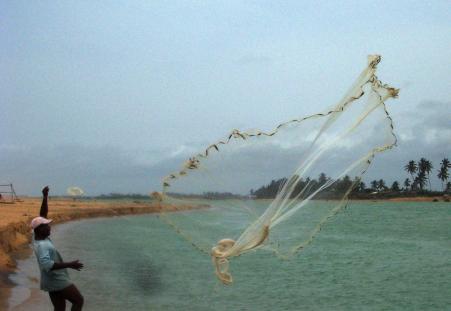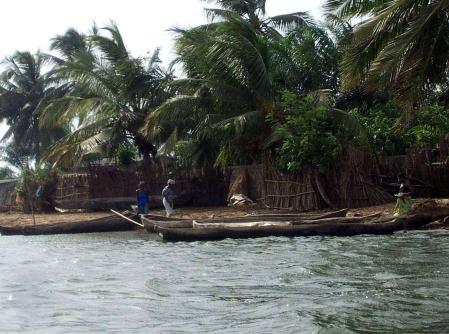The Mono River

The elephant ear of Africa stretched endlessly to our north through deserts and rubble. A young Fon by the name of Mathieu was at the tiller of our small outboard; he was an entrepreneur of the sort Africa's economic future desperately depends, and had proposed the trip to us with a hand lettered brochure on which he had painstakingly illustrated the boat trip's highlights. The Mono, sleek with the ripples of the morning's southwesterly wind, slipped beneath us to the hum of the outboard and the whisper of the morning breeze.
As our low craft slipped through wooded islets it was hard not to appreciate the tenacity of the river's march towards the rumpled Atlantic. The river's course widened appreciably in our descent: low villages of concrete and adobe huts watched us from the river's edge, children splashed each other in the warm water, and men strained to push their wooden craft in, laden with nets.

With the exception of the mighty Niger River, which unwinds in a broad, silver arc from the depths of the continent, West Africa's rivers run single-mindedly towards the coastline in courses the colonial boundaries would eventually come to parallel. Each one provided a natural target for Africa's own settlements and the European ones that would then accompany - or supplant - them, and have remained the continent's principle transport corridors through the present.
Slipping down the Mono River in a small boat felt like riding the coat
tails of history. The morning sun's vertical track melted the shadows: the
water's surface took on a shine and later, a glare. The ocean was never far
away, as the Mono in its last stretch turns eastward and runs along the coast.
There, the wooded south shore of the river turned shrubby and then dissolved
to sand, in dunes that obstructed our view of the ocean but not the sound of
thumping waves beyond them.
![]()
We passed the ruins of the old French colonial settlement of Gran Popo, built in the 16th century and doomed by a shifting river channel and the steady encroachment of the ocean: what was once well inland was now half buried in sand dunes, and easily within the hungry reach of storm surf. Not far beyond, the Beninese had built an impressive temple to the Vaudoun ("voodoo") religion, with a call to worship - "Vaudoun for peace and well being" - that was hard to disdain.
After an hour, we reached the mouth of the river, the end of the Mono. The so called "Bouche du Roi" ("mouth of the king") was tumultuous, as the river water concluded its journey in the face of a rising tide that bucked it into chaos. Mathieu pulled us into a pool carved by the current, and we disembarked to watch the river and ocean battle for a while. Beside us, a Beninese, immersed to his thighs in the river, cast a weighted throw-net, lariat-like, into the waters. With the exception of the outboard motor, the scene could as easily have been part of the 16th century.
We returned that afternoon, sunburned and happy, to our hotel: a French-owned auberge of lovely, thatch-roofed huts set on a grassy lawn. Its reception office was at one time the colonial customs building and some of the rooms are set in what was once the office of the commander, an stately building surrounded by pines. Meanwhile, the Mono, eased by a falling tide, continued to pour out the heart of Africa, sleek and timeless under the tropical sun and the lengthening shadows of history.
Trackbacks
The author does not allow comments to this entry

Comments
Display comments as Linear | Threaded